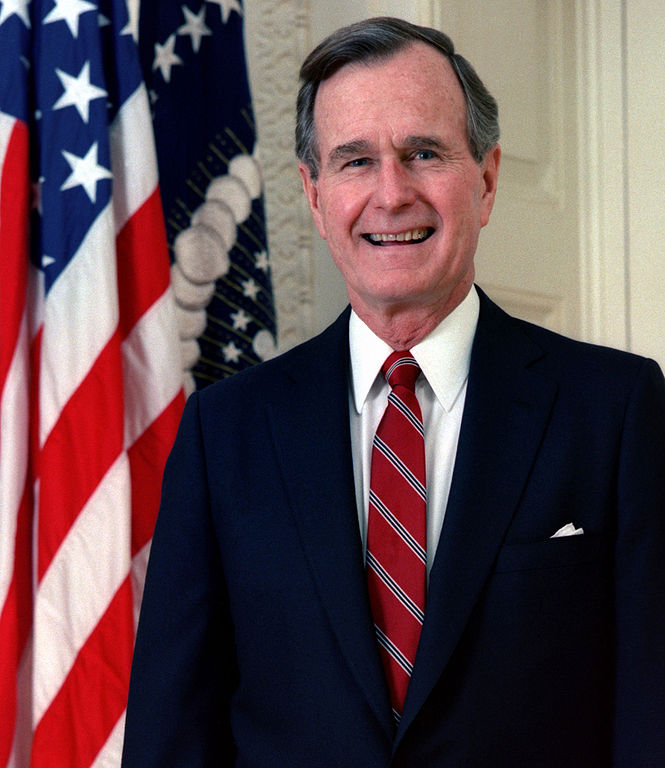 |
| George Bush |
George Herbert Walker Bush served as the fortyfirst president of the United States from 1989 to 1993. Bush’s connections to groups ranging from the Skull and Bones Society to the CIA have made him a suspicious figure in the eyes of many conspiracy theorists, but it was his declaration of an imminent New World Order at the outset of the Gulf War that gave him a central position in quasi-apocalyptic theories of the coming one-world government.
At the forefront of anti-Bush literature is the Lyndon LaRouche group. LaRouche himself strongly attacked Bush during the 1980 presidential campaign (and thereafter), and two of LaRouche’s associates, Webster Tarpley and Anton Chaitkin, have written an unauthorized version of George Bush’s life that questions every aspect of the former president’s official biography—including his supposed status as a war hero (Tarpley and Chaitkin, 108ff).
They suggest that any biographical sketch of Bush that mentions his arriving in Texas in a red Studebaker—another story they deem apocryphal—is merely a regurgitation of the few authorized “facts” the Bush family has offered the public. For the LaRouche group, Bush’s true story involves connections to Nazi bankers, international cabals, the East Coast elite, and, generally, “insiders” of all varieties.
  |
Bush’s connections to the networks of power in the United States are indeed stunning. He served as U.S. permanent representative to the United Nations from 1971 to 1973, as the first chief of the U.S. Liaison Office in China from 1974 to 1975, and as director of the CIA from 1975 to 1976.
By 1979, Bush had become a member of the board of the Council on Foreign Relations and a member of the Trilateral Commission, in both groups (as well as in his diplomatic capacity in China) dealing closely with Henry Kissinger, a black mark indeed as far as Bush’s so-called extremist critics are concerned.
To this list one could add two more connections that raise red flags for conspiracy theorists: Bush’s membership in the Skull and Bones Society while at Yale in the 1940s, and his membership (again along with Kissinger) in the Bohemian Grove group that meets annually to perform “pagan rituals” in the forest north of San Francisco.
In Bush’s first year as vice-president, John Hinckley Jr. shot Ronald Reagan, and, as far as some Bush critics are concerned, the peculiar circumstances surrounding the assassination attempt seem to implicate Bush. In spite of the fact that Hinckley had not yet been properly questioned, officials almost immediately came to the conclusion that he had acted alone.
Furthermore, no one had yet investigated the fact that George Bush’s son Neil was planning to have dinner with John Hinckley Jr.’s brother Scott on the night following the assassination attempt. This fact was not so much covered up as it was completely ignored. Also ignored, according to the LaRouche group, is the fact that the Hinckley family were major contributors to George Bush’s presidential campaign.
These facts together are taken as evidence that Hinckley may well have been a Manchurian Candidate, a product of the MK-ULTRA program that was supposedly terminated by 1973, two years before Bush became CIA director (Tarpley and Chaitkin, 375ff). Hinckley’s parents recall notes their son wrote while in prison that describe an “imaginary conspiracy” to assassinate the president, but again the LaRouche group charges that these notes have been wrongly suppressed.
While Reagan was recovering in the hospital— and while Bush was in charge of the government— an attempt was made on Pope John Paul II’s life. Tarpley and Chaitkin imply that Bush may well have had something to do with this, or at least with a subsequent cover-up, writing: “It was as if a new and malignant evil had erupted onto the world stage, and was asserting its presence with an unprecedented violence and terror” (380).
Bush was elected president in 1988, and soon thereafter spoke the words that have made him the bête noire of all those who suspect the “insiders” of preparing to subject U.S. citizens to an evil one-world government. On 11 September 1990, George Bush addressed Congress and announced the coming of “a New World Order” that would guarantee unprecedented peace and prosperity through international cooperation.
The LaRouche group and others see this New World Order as nothing less than universal slavery—the complete subjugation of the rights of the individual (and of the individual nation) in the face of a totalitarian international government (the UN as presently constituted is merely the first step in this progression). More mainstream journalists, of course, would see this New World Order as a function of impersonal forces of globalization, rather than as the product of a conscious Masonic world-conspiracy.
Even after leaving office, Bush has not ceased to be the object of critique and speculation. Those who depict Bush as having political power that is all but supernatural in scope were offered another spectacle that seemed to prove their theories in the 2000 presidential election.
Bush’s son, George W. Bush, became the forty-third president (they now refer to each other in private as forty-one and fortythree) in spite of a noticeable lack of political savvy and a complete lack of the foreign policy knowledge that marked his father’s political career. Even mainstream journalists began to wonder whether or not a vast right-wing conspiracy involving the Supreme Court was behind the final result.